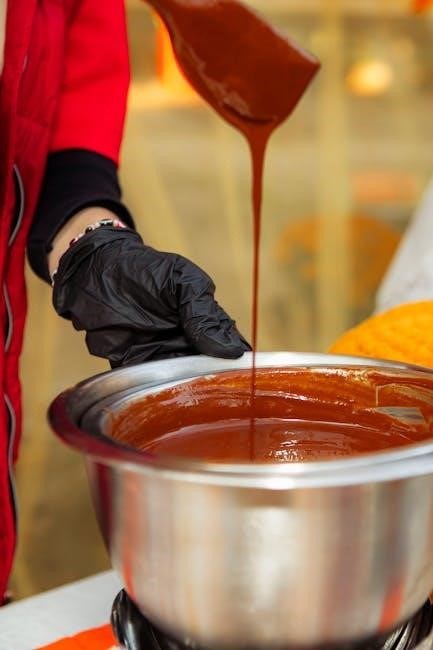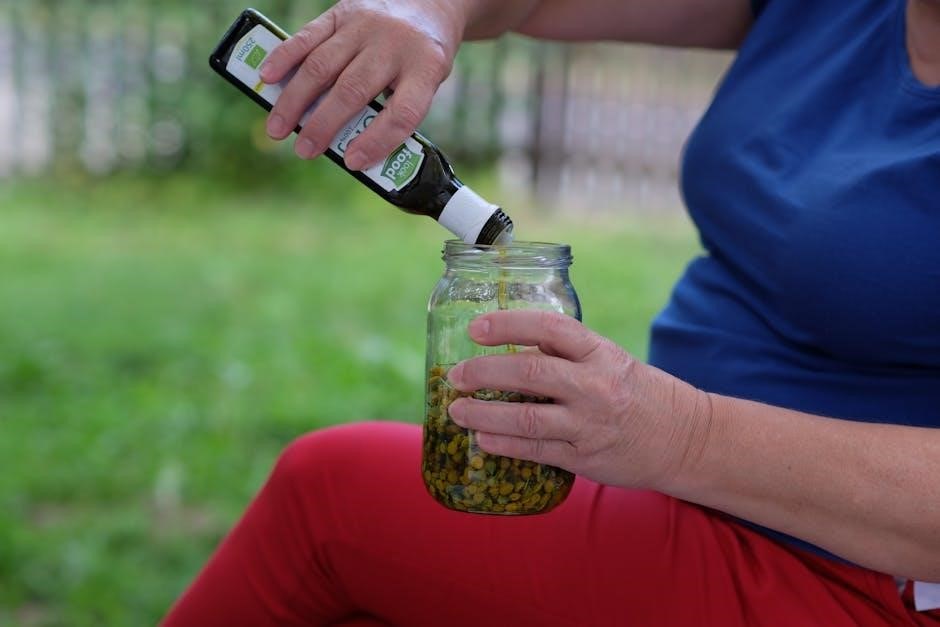PAR 3 Weed Killer is a widely used herbicide for effective weed control, popular among homeowners and professionals. It targets broadleaf weeds and is known for its selective action, making it a reliable choice for lawn care.
1.1 What is PAR 3 Weed Killer?
PAR 3 Weed Killer is a selective herbicide designed to control broadleaf weeds effectively while maintaining the health of desirable grass species. It is commonly used in lawn care and agricultural settings due to its efficiency and targeted action. The active ingredient in PAR 3 is typically 2,4-D, a widely recognized herbicide that inhibits weed growth without harming most grass types when applied correctly. PAR 3 is known for its selective properties, making it a popular choice for homeowners and professionals seeking to manage weeds in turfgrass areas. The product is available in liquid form and is usually mixed with water before application. Proper mixing and spraying techniques are essential to ensure optimal results and minimize the risk of overspray or drift. With its proven track record and ease of use, PAR 3 Weed Killer remains a preferred solution for weed control in various environments.
1.2 Benefits of Using PAR 3 Weed Killer
PAR 3 Weed Killer offers numerous benefits, making it a preferred choice for weed control. Its selective formula targets broadleaf weeds while sparing desirable grass, ensuring a healthy lawn. The herbicide is cost-effective and provides long-lasting results, reducing the frequency of applications. It is also relatively easy to mix and apply, with clear instructions that ensure proper usage. Additionally, PAR 3 is environmentally friendly when used according to guidelines, minimizing potential harm to non-target plants and water sources. Many users appreciate its reliability and effectiveness in controlling stubborn weeds that other products may fail to eliminate. Furthermore, PAR 3 Weed Killer is widely available and supported by excellent customer service, making it a practical solution for both homeowners and professionals. Its ability to maintain turf health while eradicating weeds makes it a standout product in lawn care management.
1.3 Key Components of PAR 3 Weed Killer
PAR 3 Weed Killer is formulated with active ingredients such as 2,4-D, mecoprop, and dicamba, which are effective against a wide range of broadleaf weeds. The product is typically available as a concentrated liquid, designed to be mixed with water for application. It may also contain surfactants to enhance coverage and absorption, ensuring better efficacy. Inert ingredients, such as solvents and stabilizers, are included to maintain the product’s consistency and shelf life. These components work synergistically to provide reliable weed control while minimizing harm to desirable grasses. The balanced formulation makes PAR 3 Weed Killer both efficient and environmentally friendly when used according to the recommended guidelines. Its composition supports long-lasting results, reducing the need for frequent applications and making it a practical choice for lawn care maintenance.

Safety Precautions Before Mixing
Always wear protective gear, including gloves, goggles, and a face mask, to avoid skin and eye irritation. Ensure proper ventilation to prevent inhaling fumes during mixing.
Avoid direct skin contact and ingestions. Keep the area clear of pets and children to minimize exposure risks. Follow all label instructions carefully to ensure safe handling.
2.1 Personal Protective Equipment (PPE)
When handling PAR 3 Weed Killer, it is essential to wear appropriate Personal Protective Equipment (PPE) to minimize exposure risks. This includes waterproof gloves to prevent skin contact, safety goggles to protect eyes from splashes, and a face mask to avoid inhaling fumes. Additionally, wear long-sleeved shirts, pants, and closed-toe shoes to cover skin thoroughly. Avoid wearing loose clothing that could accidentally come into contact with the herbicide. Ensure all PPE is in good condition and free from tears or holes. If mixing or spraying, consider using a respirator for added protection against airborne particles. Always follow the manufacturer’s guidelines for PPE, as improper protection can lead to skin irritation or other health issues. Double-check that all gear is properly secured before starting the mixing process. Remember, safety should never be compromised when working with chemical herbicides like PAR 3 Weed Killer.
2.2 Handling Precautions
When handling PAR 3 Weed Killer, it is crucial to exercise caution to ensure safe and effective use. Always avoid direct skin contact, as the herbicide can cause irritation. Use a clean, dedicated measuring cup or scoop specifically for the product to prevent cross-contamination with food or other chemicals. When pouring, do so slowly to minimize spills. If spills occur, clean them immediately with water to prevent accidental exposure. Avoid breathing in the dust or vapors during mixing, and work in a well-ventilated area. Keep the product away from open flames or sparks, as some components may be flammable. Never mix PAR 3 Weed Killer near open water sources or drains to prevent environmental contamination. Always follow the recommended dilution rates to avoid over-concentration, which can harm desirable plants. By adhering to these handling precautions, you can ensure a safe and efficient application process.
2.3 Storage and Disposal Guidelines
Proper storage and disposal of PAR 3 Weed Killer are essential to maintain safety and environmental protection. Store the product in a cool, dry place away from direct sunlight and extreme temperatures. Keep it out of reach of children, pets, and livestock to prevent accidental exposure. The original container should be tightly sealed after use to prevent contamination or leakage. Avoid storing the herbicide near food, water sources, or fertilizers to minimize cross-contamination risks.
- Dispose of unused solutions and empty containers according to local regulations and guidelines.
- Do not pour leftover herbicide down drains, as it may contaminate water systems.
- Check with local authorities for designated hazardous waste collection facilities.
- Wash and rinse empty containers thoroughly before disposal.
By following these storage and disposal guidelines, you can help protect the environment and ensure the safe handling of PAR 3 Weed Killer.

Mixing Instructions for PAR 3 Weed Killer
For effective weed control, mix PAR 3 Weed Killer at the recommended rate of 55ml per 3L of water for 100m². Add a surfactant to enhance coverage and absorption for optimal results;

3.1 Basic Mixing Steps
Filling your spray tank halfway with water, add the recommended dose of PAR 3 Weed Killer, then swirl gently to mix. Fill the tank to the top with water and add a surfactant if needed. Allow the solution to sit for 10-15 minutes before spraying to ensure even distribution. For optimal results, apply during calm weather when weeds are actively growing. Avoid spraying in direct sunlight or high winds to prevent drift. Wear Personal Protective Equipment (PPE) such as gloves, goggles, and a mask for safety. Always follow the label instructions for the correct dosage and mixing ratios to achieve effective weed control without harming desirable plants. Proper mixing ensures the herbicide works efficiently and minimizes environmental impact.
3.2 Measuring the Correct Dosage
Accurate measurement of PAR 3 Weed Killer is crucial for effective weed control and plant safety. Use a measuring cup or jug specifically designed for pesticides to ensure precise dosing. For general use, mix 55ml of PAR 3 in 3 liters of water per 100m². Always check the label for specific recommendations, as dosage may vary depending on weed type and growth stage. To avoid over-application, measure the product carefully and avoid exceeding the recommended rate. If using a larger spray tank, calculate the dosage proportionally to maintain the correct concentration. For example, for 10 liters of water, use approximately 183ml of PAR 3. Never measure by guesswork, as this can lead to under- or over-application, reducing effectiveness or harming desirable plants. For best results, measure in a well-ventilated area and avoid spills. Consult the product label or manufacturer guidelines for specific adjustments based on your target weeds and application area.
3.3 Adding Surfactants for Better Coverage
Surfactants are essential additives that enhance the effectiveness of PAR 3 Weed Killer by improving herbicide coverage and absorption. A surfactant reduces the surface tension of the spray solution, allowing it to spread evenly across leaf surfaces and penetrate more effectively. For optimal results, add a nonionic surfactant at a rate of 1 teaspoon per gallon of water (or as recommended on the surfactant label) after mixing the herbicide. This ensures uniform coverage and maximizes weed control. When using surfactants, always follow the manufacturer’s instructions to avoid overdosing, which can damage plants. Properly mixed solutions with surfactants improve the herbicide’s ability to adhere to waxy or hairy leaf surfaces, especially on challenging weeds like clover or dandelions. This step is critical for achieving consistent and long-lasting weed control, particularly in dense or hard-to-manage areas; By incorporating surfactants, you ensure the herbicide works more efficiently, reducing the need for reapplication and improving overall effectiveness.
3.4 Adjusting Concentration for Different Weeds
Adjusting the concentration of PAR 3 Weed Killer is crucial for effectively targeting different types of weeds. For harder-to-control weeds like dandelions or clover, increase the herbicide concentration to 60-70 ml per 3 liters of water. For lighter weeds, such as annual broadleaves, a lower concentration of 40-50 ml per 3 liters is sufficient. Always refer to the product label for specific recommendations, as over-concentration can harm desirable plants. Start with the lower end of the recommended range and adjust based on results. For weeds with waxy or hairy leaves, such as thistle, adding a surfactant improves absorption. Avoid under-diluting, as this reduces efficacy. Proper concentration ensures effective weed control while minimizing potential harm to non-target plants. Test the solution on a small area first to gauge its impact. By tailoring the mix to the weed type, you achieve better results and reduce waste. This step is vital for optimizing the herbicide’s performance and safety.

Application Best Practices
Apply PAR 3 Weed Killer during early morning or late afternoon to minimize evaporation. Calibrate spray equipment to ensure uniform coverage and avoid overspray on desirable plants. Proper timing enhances effectiveness and safety.
4.1 Optimal Time for Spraying
The optimal time for spraying PAR 3 Weed Killer is during early morning or late afternoon when temperatures are moderate, and winds are minimal. Avoid spraying under direct sunlight or when temperatures exceed 85°F, as this can lead to rapid evaporation and reduced efficacy. Additionally, ensure the area is dry, with no rain forecasted within 24-48 hours, to allow the herbicide to adhere properly to the foliage. Spraying during these optimal times enhances absorption and minimizes drift, ensuring better weed control while protecting desirable plants. Proper timing also aligns with environmental conditions, reducing the risk of overspray and maintaining the product’s effectiveness. Always check weather forecasts before application to ensure ideal conditions for spraying.

4.2 Spray Equipment and Calibration
Using the right spray equipment ensures efficient and accurate application of PAR 3 Weed Killer. Backpack sprayers, garden sprayers, or tractor-mounted units are recommended for optimal coverage. Before use, calibrate your equipment to ensure the correct application rate. Measure the swath width (the area covered in one pass) and calculate the flow rate using a measuring tape and timer. For example, if the swath is 10 feet wide and the sprayer applies 2 gallons per minute, adjust the nozzle to maintain this rate. Proper calibration prevents under-application, which may not control weeds effectively, or over-application, which could harm desirable plants. Use flat-fan nozzles for uniform coverage and ensure they are not worn out, as this can affect spray patterns. Regularly clean and maintain the equipment to prevent clogging and ensure consistent performance. Accurate calibration and proper equipment maintenance are critical for effective weed control and safety.
4.3 Avoiding Overspray and Drift
Avoiding overspray and drift is crucial when applying PAR 3 Weed Killer to protect non-target plants and the environment. Use flat-fan nozzles, as they provide uniform coverage and reduce drift. Spray when wind speeds are low (below 10 mph) to prevent particles from drifting. Avoid spraying during windy, rainy, or extremely hot conditions, as these can lead to unintended spread. Keep the spray boom low to the target area to minimize particle drift. Use a coarse spray setting rather than a fine mist to reduce airborne particles. Avoid overlapping spray patterns, as this can lead to over-application and potential runoff. If using a backpack sprayer, walk steadily and maintain consistent pressure to avoid excessive drift. Always direct the spray toward the target weeds and away from desirable plants or water sources. Properly calibrate equipment to ensure the correct flow rate, and use drift-reducing agents if necessary. By following these steps, you can minimize overspray and drift, ensuring effective weed control while safeguarding the surrounding environment and plants.

Environmental Impact Considerations
PAR 3 Weed Killer can impact non-target plants and water sources if not used properly. Avoid overspray and runoff to protect soil and aquatic life. Follow disposal guidelines to minimize environmental harm.
5.1 Toxicity to Non-Target Plants
PAR 3 Weed Killer can pose risks to non-target plants if not applied correctly. Overspray or drift may damage desirable vegetation, including ornamental plants and crops. The herbicide’s active ingredients, such as selective herbicides like 2,4-D, can inadvertently harm nearby plants if proper precautions aren’t taken. It’s crucial to follow the recommended application rates and avoid spraying during windy or rainy conditions to minimize drift and runoff. Additionally, the product’s toxicity can persist in soil or water if improper disposal occurs, potentially affecting aquatic life and soil health. Users should exercise caution to prevent accidental exposure to non-target plants, as this can lead to unintended damage or death. Always adhere to the product’s label instructions and take steps to protect surrounding flora during application. This ensures effective weed control while safeguarding the environment and non-target vegetation.
5.2 Impact on Soil and Water
PAR 3 Weed Killer can have significant environmental implications if not used responsibly. Improper mixing or excessive application may lead to soil contamination, affecting microbial activity and nutrient balance. The herbicide’s active ingredients, such as glyphosate and triclopyr, can persist in soil for extended periods, potentially altering ecosystems. Water contamination is another concern, as runoff from treated areas can carry residues into water bodies, harming aquatic life. Factors like soil type, rainfall, and application timing influence the extent of contamination. To mitigate risks, users must follow recommended mixing instructions and avoid spraying near water sources or during heavy rain. Proper disposal of unused solutions is also critical to prevent unintended environmental harm. By adhering to guidelines, users can minimize the herbicide’s impact on soil and water, ensuring safer application and protecting ecosystems.
5.3 Safe Disposal of Unused Solution
Proper disposal of unused PAR 3 Weed Killer solution is crucial to prevent environmental contamination and ensure safety. Always dispose of the mixture and its container responsibly. Do not pour leftover solution down drains, sewers, or waterways, as it can harm aquatic life. Instead, dispose of the solution by applying it to an approved area, following the product label instructions. If the solution cannot be used, contact a hazardous waste collection facility or local authorities for guidance. Empty containers should be rinsed thoroughly and disposed of according to local regulations. Never reuse herbicide containers for other purposes. Proper disposal helps protect the environment and adheres to legal standards. Always follow specific guidelines provided by the manufacturer or local waste management agencies to ensure safe and compliant disposal practices.

Troubleshooting Common Issues
Common issues with PAR 3 Weed Killer include ineffective weed control, plant damage from overspray, and mixing errors. Address these by adjusting application timing, calibrating spray equipment, and ensuring proper dosage measurements for optimal results.
6.1 Ineffective Weed Control
Ineffective weed control with PAR 3 Weed Killer can occur due to improper mixing, incorrect dosage, or environmental factors. Ensure the solution is mixed accurately, following the recommended 55ml per 3L of water for 100m². Avoid applying during heavy rain or within 24 hours of rainfall, as this reduces efficacy. Timing is critical—spray when weeds are actively growing and during calm weather to prevent drift. If weeds persist, check for resistance or hard-to-control species, which may require higher concentrations or alternative herbicides. Proper spray equipment calibration and nozzle selection are also essential for uniform coverage. Overspray on desirable plants should be minimized to avoid damage. If results remain unsatisfactory, consult the product label or seek professional advice to address specific weed types or application errors. Adjusting the surfactant levels or reapplying at the recommended interval may improve outcomes. Always follow safety guidelines to protect yourself and the environment while troubleshooting.
6.2 Plant Damage from Overspray
Plant damage from overspray when using PAR 3 Weed Killer can occur if the solution inadvertently comes into contact with desirable vegetation. This often happens due to improper spraying techniques, excessive application rates, or unfavorable weather conditions like wind drift. To prevent overspray damage, ensure precise calibration of spray equipment and use low-drift nozzles to minimize spray dispersion. Avoid spraying during windy or rainy conditions, as this increases the risk of drift and runoff. If overspray occurs, rinse affected plants thoroughly with water to reduce absorption. Monitor treated areas for signs of stress, such as yellowing leaves or wilting, and provide adequate watering to support recovery. Always maintain the recommended spray distance from non-target plants and consider using protective covers for sensitive species. If damage is severe, discontinue use and consult the product label or a professional for guidance. Proper application practices are essential to safeguard desirable plants while effectively controlling weeds.
6.4 Resolving Mixing Errors
Mixing errors with PAR 3 Weed Killer can lead to reduced efficacy or potential environmental harm. Common issues include over-dilution, under-dilution, or incorrect addition of surfactants. If too much water is added, the solution may not effectively kill weeds. Conversely, over-concentration can harm desirable plants. To resolve mixing errors, start by carefully remeasuring and recalibrating the mixture. If excess water is added, either restart the process or adjust by adding more herbicide gradually. For under-dilution, add water incrementally while agitating the mixture to achieve the correct concentration. Always refer to the product label for precise guidelines. If surfactants are omitted, they can still be added later, but ensure the solution is well-agitated. To prevent future errors, double-check measurements and use a calibrated measuring device. Proper mixing ensures safe and effective weed control while minimizing risks to non-target plants and the environment.

Alternatives to PAR 3 Weed Killer

Alternatives to PAR 3 include natural options like vinegar-based solutions, boiling water, or organic herbicides. Chemical options like glyphosate or WeedAway offer similar effectiveness. Integrated Pest Management strategies also provide eco-friendly solutions.
7.1 Other Chemical Herbicides
When seeking alternatives to PAR 3 Weed Killer, other chemical herbicides like WeedAway Premium 3-Way XP and glyphosate-based products are popular choices. These herbicides are known for their broad-spectrum activity and effectiveness against various weeds. WeedAway, for instance, combines multiple active ingredients to target tough weeds. Glyphosate-based herbicides, such as Roundup, are widely used due to their non-selective action, making them suitable for areas where total vegetation control is needed. These alternatives often come with specific mixing instructions, such as recommended dilution rates and application timings. For example, glyphosate solutions are typically mixed at a rate of 2 liters per 12 gallons of water, ensuring long-lasting control. These chemical options provide flexibility for different weed management scenarios, offering similar or enhanced results compared to PAR 3 Weed Killer.
7.2 Natural and Organic Alternatives
Natural and organic alternatives to PAR 3 Weed Killer offer eco-friendly solutions for weed control. Products like Tenacity, which contains mesotrione, are popular for targeting specific weeds while being safer for the environment. Vinegar-based herbicides are another option, using acetic acid to kill weeds on contact. These methods are ideal for those preferring non-synthetic chemicals. Organic approaches often require repeated applications for effectiveness. Surfactants can enhance coverage and absorption, improving results. Natural alternatives align with sustainable practices, reducing chemical exposure for people, pets, and wildlife. While they may not provide long-term control like synthetic herbicides, they offer a responsible choice for managing weeds in gardens and lawns. Always follow label instructions for proper use and application to ensure safety and efficacy.
7.3 Integrated Pest Management Strategies
Integrated Pest Management (IPM) combines physical, cultural, biological, and chemical controls to manage weeds effectively. For PAR 3 Weed Killer, IPM involves using it as part of a broader strategy. Cultural practices, like maintaining healthy turf through proper mowing and watering, prevent weed growth. Biological controls, such as introducing beneficial insects or microorganisms, can suppress weed populations naturally. Chemical controls, including PAR 3, are applied judiciously and at the correct concentration to minimize environmental impact. Monitoring weed populations and adjusting strategies based on observations ensures long-term efficacy. IPM emphasizes sustainability and reduces reliance on chemical herbicides. By integrating these methods, users can achieve balanced weed control while protecting the environment and promoting ecosystem health.